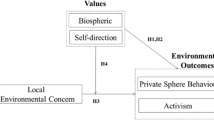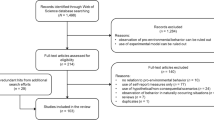Abstract
Previous research has reported that females are more likely than males to do pro-environmental behaviors. This research focused on understanding this relationship by exploring individual difference characteristics that may explain the sex difference, specifically traits and psychological barriers to pro-environmental action. Two studies (N = 246 and N = 357) confirm that males were less likely to report doing pro-environmental behaviors; males also reported more of Gifford’s (2011) Dragons of Inaction Psychological Barriers (DIP-Barriers) to pro-environmental action than females. Broad traits predicted pro-environmental attitudes and behaviors similar to past research, but they did not account for the sex difference. In addition, we suggest a new psychological barrier for males: perceptions of femininity may dissuade males from some pro-environmental behaviors. Results provide preliminary support for this idea and complement previous suggestions that environmentalism is perceived as more feminine. We discuss ways that future research can build on these suggestions with the ultimate goal of more effectively promoting environmentalism to males.



Similar content being viewed by others
Notes
In this paper, sex (male & female) refers to biological sex at birth, whereas gender refers to gender identity the person feels internally (this generally connotes what it means to be a man or a women in a culture). We also explore masculinity and femininity in this study (assessed through the Traditional Masculinity-Femininity Scale; Kachel et al., 2016). Some previous research discussed in this paper did not explicitly identify whether sex, gender, or masculinity-femininity was assessed; in these cases we use the term used in those reports as our best guess.
To easily compare the effect sizes, we mathematically transformed Pearson’s correlation r into Cohen’s d (see https://www.escal.site).
References
Andreychik, M. R., & Migilcaccio, N. (2015). Empathizing with others’ pain versus empathizing with others’ joy: Examining the separability of positive and negative empathy and their relation to different types of social behaviors and social emotions. Journal of. Basic and Applied Social Psychology, 37(5). https://doi.org/10.1080/01973533.2015.1071256
Arnocky, S., & Stroink, M. (2011). Gender differences in environmental concern and cooperation: The mediating role of emotional empathy. Current Research in Social Psychology, 16(9), 1–14.
De Backer, C., Erreygers, S., De Cort, C., Vandermoere, F., Dhoest, A., Vrinten, J., & Van Bauwel, S. (2020). Meat and masculinities. Can differences in masculinity predict meat consumption, intentions to reduce meat and attitudes towards vegetarians? Appetite, 147, 104559. https://doi.org/10.1016/j.appet.2019.104559
Bamberg, S., & Möser, G. (2007). Twenty years after Hines, Hungerford, and Tomera: A new meta-analysis of psycho-social determinants of pro-environmental behavior. Journal of Environmental Psychology, 27, 14–25. https://doi.org/10.1016/j.jenvp.2006.12.002
Blocker, T. J., & Eckberg, D. L. (1989). Environmental issues as women's issues: General concerns and local hazards. Social Science Quarterly; Austin, Tex., 70(3), 586–593.
Borau, S., Elgaaied-Gambier, L., & Barbarossa, C. (2021). The green mate appeal: Men’s pro-environmental consumption is an honest signal of commitment to their partner. Journal of Psychology & Marketing, 38(2), 266–285. https://doi.org/10.1002/mar.21321
Brody, C. J. (1984). Differences by sex in support for nuclear power. Social Forces, 63(1), 209–228.
Brough, A. R., Wilkie, J. E. B., Ma, J., Isaac, M. S., & Gal, D. (2016). Is eco-friendly unmanly? The green-feminine stereotype and its effect on sustainable consumption. Journal of Consumer Research, 43(4), 567–582. https://doi.org/10.1093/jcr/ucw044
Center for Food Safety and Applied Nutrition. (2021). Imperfect produce. United States Food and Drug Administration. https://www.fda.gov/food/consumers/food-loss-and-waste
Chan, H. W., Pong, V., & Tam, K. P. (2019). Cross-national variation of gender differences in environmental concern: Testing the sociocultural hindrance hypothesis. Environment and Behavior, 51(1), 81–108. https://doi.org/10.1177/0013916517735149
Chen, A., & Gifford, R. (2015). “I wanted to cooperate, but...”: Justifying suboptimal cooperation in a commons dilemma. Canadian Journal of Behavioral Science/Revue Canadienne des Sciences du Comportement, 47(4), 282–291. https://psycnet.apa.org/doi/10.1037/cbs0000021
Desrochers, J. E., Albert, G., Milfont, T. L., Kelly, B., & Arnocky, S. (2019). Does personality mediate the relationship between sex and environmentalism? Personality and Individual Differences, 147, 204–213. https://doi.org/10.1016/j.paid.2019.04.026
DiDonato, T. E., & Jakubiak, B. K. (2016). Sustainable decisions signal sustainable relationships: How purchasing decisions affect perceptions and romantic attraction. The Journal of Social Psychology, 156(1), 8–27. https://doi.org/10.1080/00224545.2015.1018858
Farrelly, D., & Bhogal, S. M. (2021). The value of pro-environmental behavior on mate choice. Journal of Personality and Individual Differences, 179, 110964. https://doi.org/10.1016/j.paid.2021.110964
George, D. L., & Southwell, P. L. (1986). Opinion on the diablo canyon nuclear power plant: The effects of situation and socialization. Social Science Quarterly; Austin, Tex., 67(4), 722–735.
Gifford, R. D. (2011). The dragons of inaction: Psychological barriers that limit climate change mitigation and adaptation. American Psychologist, 66(4), 290–302. https://doi.org/10.1037/a0023566
Gifford, R. D., & Chen, A. K. (2017). Why aren’t we taking action? Psychological barriers to climate-positive food choices. Climatic Change, 140(2), 165–178. https://doi.org/10.1007/s10584-016-1830-y
Gifford, R., Lacroix, K., & Chen, A. (2018). Understanding responses to climate change: Psychological barriers to mitigate and a new theory of behavioral choice. Psychology and Climate Change: Human Perceptions, Impacts, and Responses, 161–183. https://doi.org/10.1016/B978-0-12-813130-5.00006-0
Gifford, R., & Nilsson, A. (2014). Personal and social factors that influence pro-environmental concern and behaviour: A review. International Journal of Psychology, 49(3), 141–157. https://doi.org/10.1002/ijop.12034
Hamilton, L. C. (1985). Concern about toxic wastes: Three demographic predictors. Sociological Perspectives, 28(4), 463–486. https://doi.org/10.2307/1389229
Kachel, S., Steffens, M. C., & Niedlich, C. (2016). Traditional masculinity and femininity: Validation of a new scale assessing gender roles. Frontiers in Psychology, 7, 956. https://doi.org/10.3389/fpsyg.2016.00956
Kormos, C., & Gifford, R. (2014). The validity of self-report measures of proenvironmental behavior: A meta-analytic review. Journal of Environmental Psychology, 40, 359–371. https://doi.org/10.1016/j.jenvp.2014.09.003
Lacroix, K., & Gifford, R. (2018). Psychological barriers to energy conservation behavior: The role of worldviews and climate change risk perception. Journal of Environment and Behavior, 50(7), 749–780. https://doi.org/10.1177/0013916517715296
Lacroix, K., Gifford, R., & Chen, A. (2019). Developing and validating the dragons of inaction psychological barriers (DIPB) scale. Journal of Environmental Psychology, 63, 9–18. https://doi.org/10.1016/j.jenvp.2019.03.001
Landry, N., Desrochers, J. E., Hodges-Simeon, C., & Arnocky, S. (2019). Testosterone, facial and vocal masculinization and low environmentalism in men. Journal of Environmental Psychology, 64, 107–112. https://doi.org/10.1016/j.jenvp.2019.05.007
Luchs, M. G., Mooradian, T. A. (2012). Sex, personality, and sustainable consumer behavior: Elucidating gender effect. Journal of Consumer Policy, 35, 127–144. https://doi.org/10/1007/s10603-011-9179-0.
Marquart-Pyatt, S. T. (2008). Are there similar sources of environmental concern?. Comparing industrialized countries. Social Science Quarterly, 89(5), 1312–1335. https://doi.org/10.1111/j.1540-6237.2008.00567.x
McCright, A. M. (2010). The effects of gender on climate change knowledge and concern in the American public. Population and Environment, 32, 66–87. https://doi.org/10.1007/s11111-010-0113-1
Mies, M. & Shiva, V. (2014). Ecofeminism [2nd edition]. Zed Books.
Milfont, T. L., & Duckitt, J. (2010). The environmental attitudes inventory: A valid and reliable measure to assess the structure of environmental attitudes. Journal of Environmental Psychology, 30(1), 80–94. https://doi.org/10.1016/j.jenvp.2009.09.001
Mobley, C., & Kilbourne, W. (2012). Gender differences in pro-environmental intentions: A cross-national perspective on the influences of self-enhancement values and views on technology. Sociological Inquiry, 83(2), 310–332. https://doi.org/10.1111/j.1475-682X.2012.00431.x
Pew Research Center. (2019a). A look at how people around the world view climate change. https://www.pewresearch.org/fact-tank/2019/04/18/a-look-at-how-people-around-the-world-view-climate-change/
Pew Research Center/ (2019b). Americans say they’re changing behaviors to help the environment – but is it making a difference? https://www.pewresearch.org/fact-tank/2019/12/19/americans-say-theyre-changing-behaviors-to-help-the-environment-but-is-it-making-a-difference/
Ruby, M. B., & Heine, S. J. (2011). Meat, morals, and masculinity. Appetite, 56(2), 447–450. https://doi.org/10.1016/j.appet.2011.01.018
Schultz, P. W., Gouveia, V. V., Cameron, L. D., Tankha, G., Schmuck, P., & Franěk, M. (2005). Values and their relationship to environmental concern and conservation behavior. Journal of Cross-Cultural Psychology, 36(4), 457–475. https://doi.org/10.1177/0022022105275962
Scripps Institution of Oceanography. (2021, June 24). The Kneeling Curve. https://keelingcurve.ucsd.edu/
Soto, C. J., & John, O. P. (2017). Short and extra-short forms of the big five Inventory-2: The BFI-2-S and BFI-2-XS. Journal of Research in Personality, 68, 69–81. https://doi.org/10.1016/j.jrp.2017.02.004
Soutter, A. R. B., Bates, T. C., & Mõttus, R. (2020). Big five and HEXACO personality traits, proenvironmental attitudes, and behavior: A meta-analysis. Perspectives on Psychological Science, 15(4), 913–941. https://doi.org/10.1177/1745691620903019
Strapko, N., Hempel, L., MacIlroy, K., & Smith, K. (2016). Gender differences in environmental concern: Reevaluating gender socialization. Society & Natural Resources, 29(9), 1015–1031. https://doi.org/10.1080/08941920.2016.1138563
Swim, J. K., Gillis, A. J., & Hamaty, K. J. (2020). Gender bending and gender conformity: The social consequences of engaging in feminine and masculine pro-environmental behaviors. Sex Roles, 83, 363–385. https://doi.org/10.1007/s11199-019-01061-9
Tindall, D. B., Davies, S., & Mauboules, C. (2003). Activism and conservation behavior in an environmental movement: The contradictory effects of gender. Society & Natural Resources, 16(10), 909–932. https://doi.org/10.1080/716100620
United States Environmental Protection Agency. (2019). National overview: Facts and figures on materials, wastes and recycling. United States Government. https://www.epa.gov/facts-and-figures-about-materials-waste-and-recycling/national-overview-facts-and-figures-materials
Zelezny, L. C., Chua, P. P., & Aldrich, C. (2000). New ways of thinking about environmentalism: Elaborating on gender differences in environmentalism. Journal of Social Issues, 56(3), 443–457. https://doi.org/10.1111/0022-4537.00177
Acknowledgments
Acknowledgment of the qualitative data coding by Stephanie Woodall and Alyssa Ellenor.
This study with human participants was approved by Carleton University Research Ethics Board B (# 112099, February 10th 2020) and it was performed in line with the principles of the Declaration of Helsinki. Informed consent was obtained from all individual participants included in the study.
Funding
This work was supported in part by funding from the Social Sciences and Humanities Research Council: #752–2020-2693; Social Sciences and Humanities Research Council Insight Grant, #435–2020-0852.
Author information
Authors and Affiliations
Corresponding author
Ethics declarations
Conflict of interest
We have no known conflict of interest to disclose.
Materials, data, and analyses can be found at: https://osf.io/8txc6/
Additional information
Publisher’s note
Springer Nature remains neutral with regard to jurisdictional claims in published maps and institutional affiliations.
Supplementary Information
ESM 1
(DOCX 40 kb)
Rights and permissions
Springer Nature or its licensor holds exclusive rights to this article under a publishing agreement with the author(s) or other rightsholder(s); author self-archiving of the accepted manuscript version of this article is solely governed by the terms of such publishing agreement and applicable law.
About this article
Cite this article
Desrochers, J.E., Zelenski, J.M. Why are males not doing these environmental behaviors?: exploring males’ psychological barriers to environmental action. Curr Psychol 42, 25042–25060 (2023). https://doi.org/10.1007/s12144-022-03587-w
Accepted:
Published:
Issue Date:
DOI: https://doi.org/10.1007/s12144-022-03587-w




